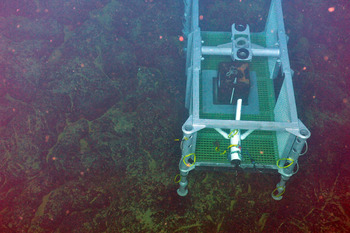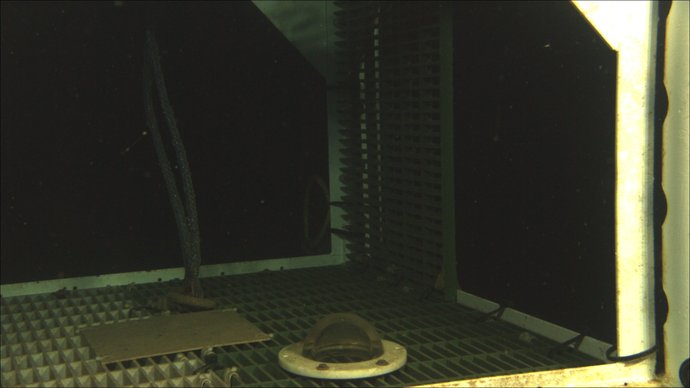
Half-size test frame being deployed off the deck of the Thompson during Enlighten 10 cruise.

Half-size Test Frame Being Deployed in 2010

A full-sized frame was sucessfully deloyed and recovered in the International District Hydrothermal Field at Axial Seamount using ROV ROPOS during the August 2011 VISIONS '11 expedition. A similar frame, when fully built out, will house the equipment to provide power and communications to extension cables and sensors deployed within the Axial Caldera. The nodes will be installed in 2013 at thsi site.

Full-size RSN Test Frame
During the Enlighten '10 cruise in August 2010, RSN Engineers deployed two half-size test frames, one at Hydrate Ridge and one at Axial Seamount. Designed to hold the low- and medium-power junction boxes on the RSN secondary infrastructure, the frames had been built at APL and were deployed to test year-long effects of corrosion and biofouling on materials and coatings. A test plexiglass panel and camera dome on each frame had been coated on one-half of their exposed surfaces with a new material called ClearSignal, which is intended to prevent attachment by marine organisms.
In early August 2011, thanks to images taken by the WHOI ROV JASON of the frame deployed at Axial, Senior Ocean Engineer Skip Denny learned that the lava flows from the April 2011 eruption at Axial had stopped just short of the test frame. From the same images, Denny could see that there was little corrosion and only minor biofouling.
During the VISIONS '11 cruise (11 August to 1 September 2011) the two half-size test frames were recovered and brought to the Laboratory for analysis. Corrosion expert and RSN Principal Mechanical Engineer Colin Sandwith has conducted his initial analysis of the biofouling and reports that it appears there are hydroids growing on the frames. Hydroids are multicelled filter-feeding animals that are clear, and therefore not a problem, when they are wet. RSN Project Scientist Orest Kawka has begun his analyses of the nutrient and oxygen profiles taken in the vicinities of the test frames so that these profiles may be cross-correlated with any observed corrosion and biofouling.
Work done during VISIONS '11 also included a test deployment and recovery of a full-size frame. The goal of this test, which was successful, was to assess the latching system and frame clearances to the ROV ROPOS, which was the ROV used throughout VISIONS '11.

